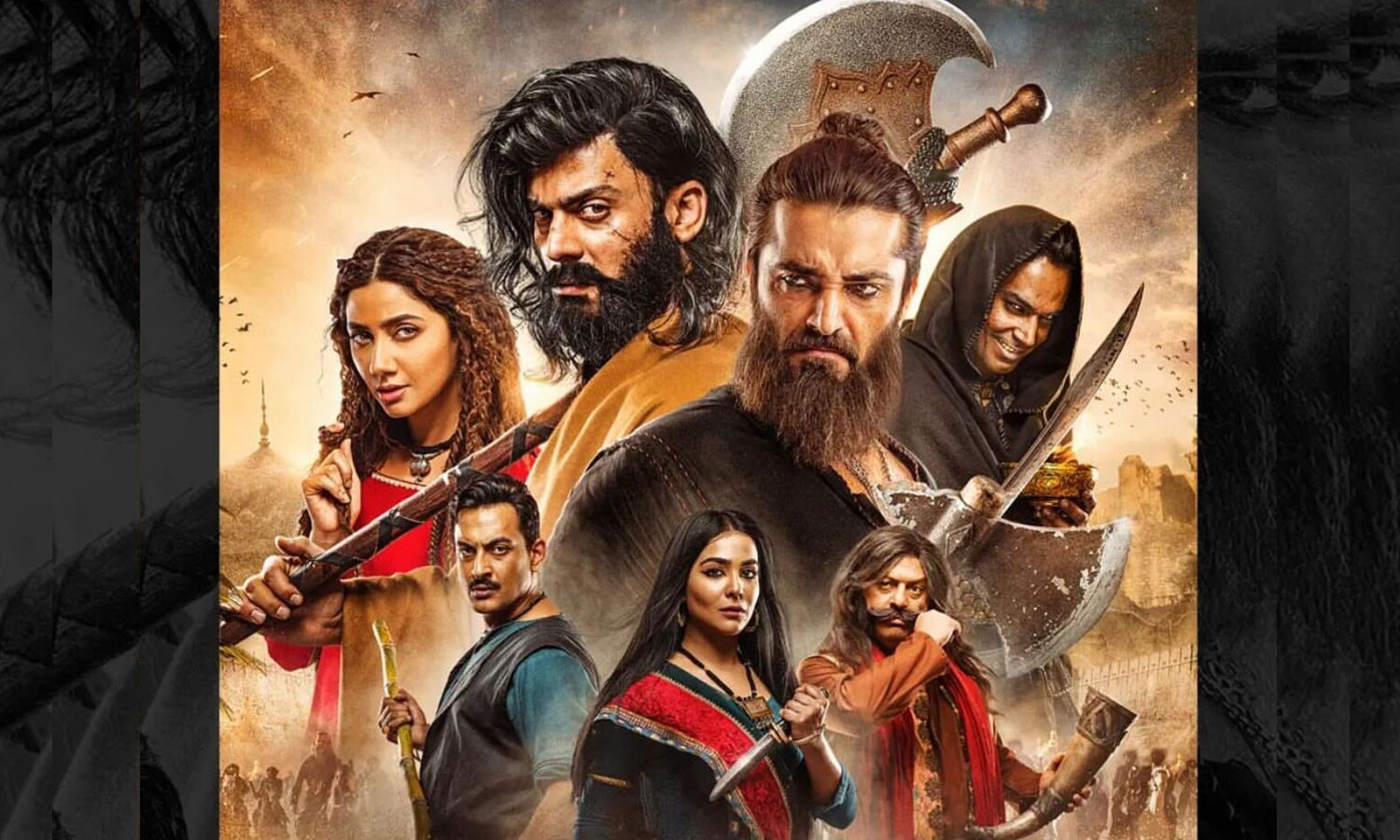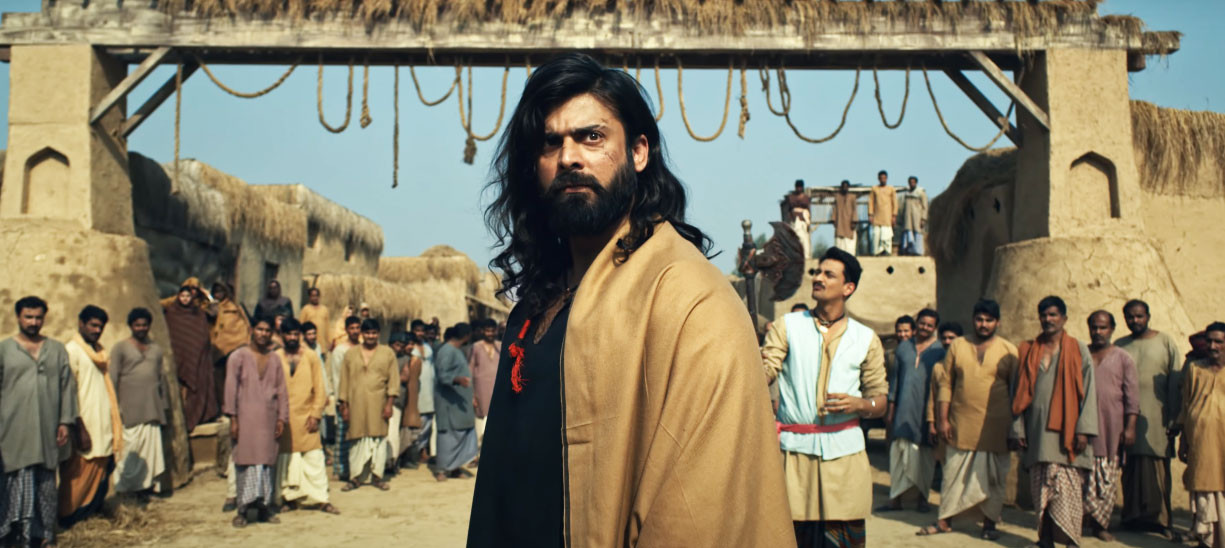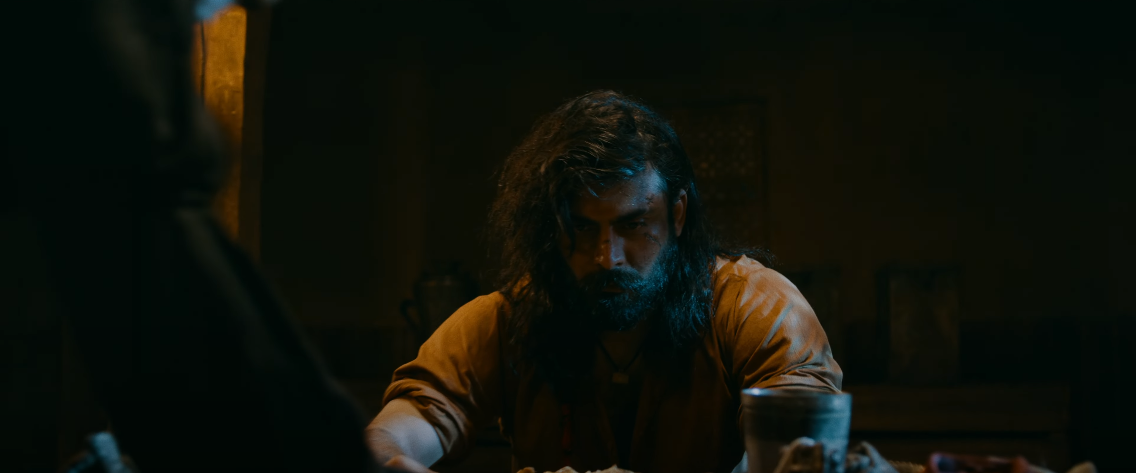'The Legend of Maula Jatt' review: Pakistani cinema's grandest offering yet
Bilal Lashari proves himself to be Pakistan’s only master of action
KARACHI:Not carved into packs but built up like a giant, his eyes peep out of a forest of facial hair, lips drown in a desi ale of sorts. From afar he is a monster and up close, a man-child, waiting to be tamed with a soother. The world is scared of his shadow, but to the one he means the word, he is the light in the sky, the sparkle in the eyes, of the prettiest woman in the neighbourhood, who is always there to balm his bruises. The bruises are there for fighting evil, for vengeance, for slashing hoards in seconds, for crushing skulls with a punch, for choosing arms over weapons for the enemy is often not worthy.
What might seem like a page out of Rocky from KGF action drama is actually a scene out of Bilal Lashari’s The Legend of Maula Jatt (TLoMJ) with a lot more devotion to sense than its South Asian parallels. While the overall choice of shots, some sequences and even editing are reminiscent more of Lashari’s love for anime, it is the strange ageing process that TLoMJ has gone through that it now stands, neck to neck, with Rajmoulie and Prashanth league of cinema, at least for the desi audiences.

Save for a few exceptionally directed sequences by Ahsan Rahim in Teefa in Trouble, TLoMJ proves that Lashari is Pakistan’s only master of action. It also proves we also have exceptions like Lashari, who takes his time to helm something truly extraordinary and that too with no filler songs, instead of churning out similar films every year.
An answer to KGF
The best part about TLoMJ, however is not its grandeur and scale; this is also why it is a notch up from the Prashanth Neel brand of cinema – the brilliance derives from a fairly simple plot and execution that doesn’t overcomplicate the narrative or test your bladder. The intermission and the cold open collided just when you thought you wanted the film to go on for another five and the film ends right before you are anticipating another major clash; that grip on the narrative and pace is common to cut scenes in videogames that users can control but leave the cinema audiences, who are there for a collective experience on a unanimous high.
TLoMJ also doesn’t have the advantage of divine interventions and inexplicable miracles, something that not only contemporary South Indian cinema thrives on, but the original Maula and its sequels toyed with. Unlike the Pakistani films of the original Maula Jutt’s milieu, there are no duas, no black magic, just good old stored masculinity, and just like a Pakistani film of any milieu, the stored masculinity and sexuality keep on hitting the gates that never open. It’s a hard reality that stands tall in front of the audiences as they watch a variety of sexually tense moments rush for an outcome.

Sadly enough, they go, as they come… Lashari has made sure that the film is packed to the brim with onscreen male virility that finds no healthy outlet for release. It knocks on the doors of hetero and homo eroticism, of sadism, masochism and sadomasochism, ending up defeated and pleading before the altar of suicide ideation. In repression, it unintentionally reflects contemporary Pakistani attitudes to any and all forms of sexual expression, which some might argue, is responsible for some of our most abhorrent sexual excesses.
This underlying, unnerving, almost volcanic, stored sexual energy isn’t just a cosmetic set-up for a few sultry Humaima moments it sets the ground for an arena full of men willing to slash each other to pieces in the name of honour, revenge and legacy.
A revamp of Maula Jutt was always inevitable; the question was always how are you going to create something new out of it, and Lashari has answered that with no lenience to the woke crowd that is going to find some consolation in Daro's (Humaima Malick) matriarchal authority. That’s it. Expect the rest of the film to be shredded through ‘deconstruction’ as a symptom of our times if the producers can’t come up with a better justification for a film driven by masculine rage being driven by that only; both the audiences and Sigmund Freud are in for a ride.
Going to the point of milieus, the strong detachment even results in a few shortcomings, particularly in the action choreography. While Lashari covers it up with some smart filmmaking solutions, fight choreography emerges as one aspect that may require a few more tries for our industry to get the hang of.

For the most part, Lashari chooses to mask the violence with character reactions and postproduction blood. Where the fight scenes are allowed some space on the screen, the ‘influences’ make themselves known almost immediately – like the one that imitates the sword and sandals epic Troy. The influences also mean there is no signature choreographic style – think the Matrix franchise's ballet-like sequences versus John Wick's grittiness. Lashari misses the chance to incorporate a local flavour into the fight choreography canon, albeit understandably so.
Although not necessarily a shortcoming, TLoMJ’s visual palette is peppered with anachronisms and idiosyncrasies. While trying to stay true to a Punjab-inspired visual language, Lashari opts for certain set and prop elements that stick out. Anglo-Saxon wood barrels and tables inside a mud structure doubling as a pub.
Bladed weapons that look more in place among thrift store wall hangers than any actual field of battle. The gandasa itself is iconised as something else, ignoring the fact that the implement Sultan Rahi turned into a celebrated weapon was originally a farming tool, much in the same way as the dreaded grim reaper’s scythe. Make of it what you will. In an ideal world perhaps, the makers of TLoMJ could have played more with local visual elements – we have our own iconic swords, shields, axes and whatnot.
Fights and masculinity

On the topic of fights and masculinity, TLoMJ reveals itself to be rather one-note and shallow. Epic tales in heroic tradition explore the pinnacle of masculinity in rather diverse ways. In Greek myths, for instance, where Hercules epitomises brute strength and straightforward solutions, figures like Theseus and Odysseus are known for their cunning.
The ill-fated Oedipus, before his life becomes a nightmare, outwits the Sphinx at her own game of riddles. Orpheus, the original rockstar perhaps, brings a tear to even Hades’ eye through the power of music as he seeks to rescue the love of his life from death itself. The same can be said of other mythic and heroic traditions all over the world.
There is more to men and masculinity than shouting matches and brute force. In the world of TLoMJ, however, there is only one. The only antidote to the masculine terror of its villains is hypermasculinity. No battle of wits, or even resolve and endurance. The answer to violence is more violence.
TLoMJ also misses a chance to explore the forgotten humanist origins of the now-mythical cinematic character. As pointed out in another article for this publication, Ahmed Nadeem Qasmi conceived Maula in a story called Gandasa for a different purpose altogether – to critique a culture that exalts vengeance and total dominance over foes as the only form of masculinity. Instead of returning Maula to his literary roots, Lashari doubles down on making an action entry. Fair enough, the cinema needs all sorts of entertainment, from light-hearted to bloody.
Performances to remember

Pakistani women, especially Mahira Khan, finally gets a role that will be remembered for her on the big screen. Despite limited screen time, she brings the combo of innocence and feistiness alive and shares a few completely arresting moments with Fawad Khan. Thanks to an original ‘Dunya taun apni kahaani’ by Sarmad Ghafoor that appears diegetically as sung by Fawad and Mahira and builds up from a tappa of sorts into an anthem that fades away in no time.
While Mallick was trolled last time, she made a stage appearance alongside Imran Khan (amplifier) at the PSL ceremony; her performance and command over Daro offer salvation for all her sins. Her character is more of a slow burn that seems monotonous in the beginning and melts over time.
Hamza Ali Abbasi as Noori Nath is exactly how you imagined Hamza Ali Abbasi as Noori Nath; he is animated, loud, and makes the most out of his baritone. You can’t find an alternate performer who could look such a giant on-screen and yet retain a sense of humanity without having an ounce of forgiveness for anyone, all at the same time, in every dialogue and each close-up.
Fawad was right to say that he had to perform well to match how well Hamza as Noori and he took quite a few notes. Khan not only delivers back to Hamza but sometimes also overpowers him, thanks to exceptionally well-written dialogues by Naser Adeeb that Fawad delivers with ease and comfort that doesn’t look rehearsed at all. He also gets the advantage of a few short and powerful moments of romantic encounter with Mahira, again aided so well by Ghafoor’s music.

Faris Shafi is a sidekick you expected Gohar Rasheed to play and Gohar is a villainous Maakha you’d have expected Nayyar Ejaz to play had it not been for the age bracket. Both of them leave a mark in the first half and both of them stay with you till the second.
Some might argue that TLoMJ’s comparison to the likes of KGF is unfair; it is only because neither the Pakistani performers nor the audiences are used to this kind of cinema. The scale of action, the play with masculinity and simple themes of revenge, innocence and retribution on the part of a male with a troubled childhood are all too uncanny to ignore.
While the film borrows nothing but the characters and bits of plot from the original, the themes it quite bravely endorses in this day and age call for a broader study of a shared sense of masculinity and rethinking of the box office prospects of South Indian cinema in Pakistan, in a better political climate of course.
Verdict: Both the audience and Sigmund Freud for in for a joyride. Go get your tickets now.
Rating: 4 stars
Have something to add to the story? Share it in the comments below.


COMMENTS
Comments are moderated and generally will be posted if they are on-topic and not abusive.
For more information, please see our Comments FAQ